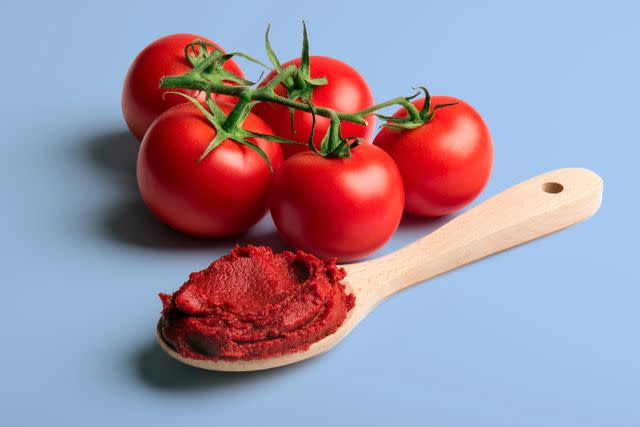What's the Difference Between Tomato Sauce and Tomato Paste? We Break It Down
Consistency is key.
Fact checked by Haley Mades
Tomatoes are technically fruits, but we treat them like vegetables because they’re a staple in savory dishes. Think about the most common ways we use tomatoes—pizza, pasta, gazpacho, salad, sandwiches, burgers, salsa—need we say more? Given their versatility, it should come as no surprise that tomatoes are the third most purchased type of produce in America, with a whopping 81% of households buying the juicy goodness on repeat.
You can buy tomatoes all year long, but they’re usually freshest during the summer and fall, depending on where you live. Outside of tomato season, or when the recipe calls for it, canned tomatoes can be just as good and sometimes even better than the fresh fruit. According to the Academy of Nutrition and Dietetics, canned fruits and vegetables are picked at peak ripeness, so they’re full of nutrients and flavor.
Diced, peeled, and crushed are a few types of canned tomatoes, but tomato sauce and tomato paste are the key to getting a concentrated tomato flavor short of plucking tomatoes from the vine yourself. More than 221 million Americans used tomato sauce in 2020, while nearly 172 million Americans used tomato paste. But, what’s the difference between the two, and what can you do with them? It’s time to clear up some confusion surrounding these flavor-enhancing pantry staples and delve into the difference between tomato sauce and tomato paste.
Related: How to Store Tomatoes So They Don't Get Mealy

omersukrugoksu/Getty Images
Tomato Sauce vs. Tomato Paste
Let’s cut to the chase: What are tomato sauce and tomato paste, how are they different, and how do we use them?
What is Tomato Sauce?
According to the USDA, tomato sauce is the concentrated, liquid extraction from mature tomatoes, and it may have added seasonings, vinegars, or sweeteners. It’s made from cooked tomatoes that are left to simmer until some of the liquid from the tomatoes has evaporated. It’s not as chunky as other tomato products, so it’s a good liquid base for adding other ingredients, such as soups, chilis, stews, and other tomato-based sauces. Its consistency is comparable to gravy.
You can make it at home, or you can grab a few jars of tomato sauce at most grocery stores. There are even a few different varieties of store-bought tomato sauce, such as plain, no salt added, organic, or Italian-style. Most store-bought tomato sauces include herbs and spices like salt, sugar, vinegar, garlic, onion, bell pepper, and basil.
Related: 7 Substitutes for Tomato Sauce If You Run Out of the Pantry Staple
What is Tomato Paste?
Tomato paste, on the other hand, is a super-thick and bright red paste made from, you guessed it, tomatoes. It’s the most concentrated form of tomatoes you can get (with the least amount of water), as it’s made by cooking down and straining tomatoes until the final product has a thick consistency.
Related: 6 Substitutes for Tomato Paste to Use When You Run Out of the Real Thing
What’s the Difference?
The main differences between tomato sauce and tomato paste are its texture, which is a direct result of each product’s concentration of tomato (vs water), and additives:
Flavor: Tomato paste is more concentrated, so it has a more potent flavor. You need significantly less tomato paste (than sauce) to get that tomato flavor you want.
Consistency: Tomato sauce is significantly thinner. Tomato paste is so thick, it doesn't pour.
Seasonings: Tomato paste doesn’t have added seasonings and tomato sauce often does.
Nutrition: Cup for cup, tomato paste has more of just about everything—calories, carbs, and nutrients—because it's more concentrated than tomato sauce. Yet less paste is generally used in recipes compared to sauce so nutritionally, their health benefits are comparable.
Tips
If you're concerned about added sugar, check your tomato sauce label. Between paste and sauce, tomato sauce is more likely to contain added sugar.
Related: The 30 Healthiest Foods to Eat Every Day
When to Use Tomato Sauce vs. Tomato Paste in Your Cooking
Each product's texture affects how each is used in cooking:
Reach for tomato sauce when you need a liquid vehicle for that tomato flavor, such as in pasta sauce, soups, and stews. Use this tomato-based ingredient to add flavor along with some liquid like for sloppy joe’s, ground beef seasoning, pizza sauce, and meatball subs.
Tomato paste comes in handy when you need a punch of tomato flavor, like in sauces and soups, but don’t want to add extra liquid to the mix. You only need a couple of spoonfuls of tomato paste in recipes like tomato bisque, vodka sauce, chili, and homemade ketchup. It’s also a popular addition to meat loaf, shepherd’s pie, and minestrone soup.
What About Marinara Sauce?
Marinara sauce and tomato sauce have a lot in common, but they’re not the same:
Versatility: Marinara, a type of tomato-based sauce, is less versatile than tomato sauce and is usually reserved for pasta dishes and pizza.
Ingredients: Marinara typically has fewer ingredients—often just garlic, basil, and red peppers—while tomato sauce typically includes vinegar, sweeteners, herbs, and spices.
Consistency: Marinara is thinner than tomato sauce.
Simplicity: Marinara is generally easier and quicker to whip up, so if you want to learn how to make pantry staples from scratch, marinara sauce is a good place to start.
For more Real Simple news, make sure to sign up for our newsletter!
Read the original article on Real Simple.

